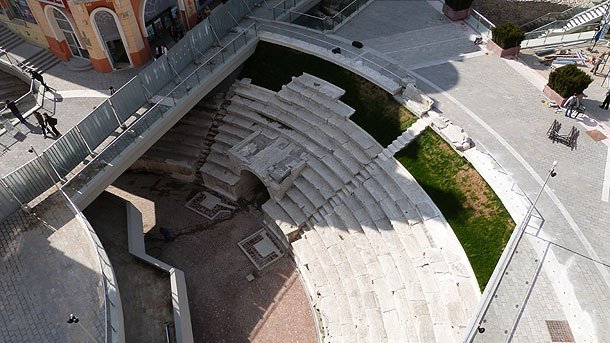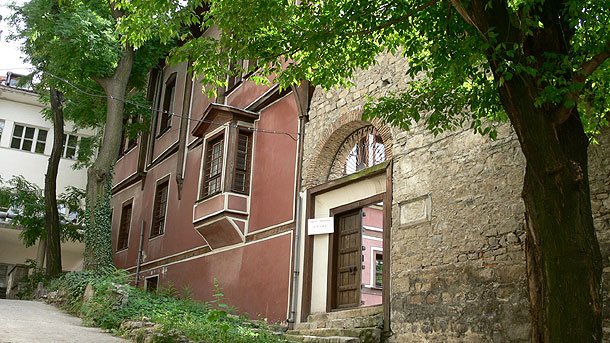A town older than Rome-this is the town of Plovdiv. Some 8000 years have passed since the foundation of one of the oldest places in Europe, situated in Western Bulgaria. The citizens of Plovdiv, like the people from Rome call their town the Eternal city. That is why the first place where people of Plovdiv take their guests to is the Architectural historic preserve “Ancient Plovdiv”. Here one can see the marks left from few different periods, from antiquity to modern days. Amongst the remains of old fortress walls the tourist can follow all historic layers from the Thracian period and the Roman Empire period. The Bulgarian National Revival period has left a mark in each one of the local houses. Ancient Plovdiv was included in the list of the 100 national tourist sites and has many visitors. The spirit of the past there co-exists with the modern life.

© Photo: wikipedia.org
The guide Rumqna Stoeva-Tyteriakova introduces us to the spirit of Ancient Plovdiv with a story about two antique theatres.
“One of the antique theatres in Ancient Plovdiv was immense- it could seat 10% of the total population of Plovdiv. This theatre functions at present and it provides great acoustic for the audience. It is a host of many plays as well as of spectacular opera performances, mainly by Giuseppe Verdi, as the town of Plovdiv traditionally hosts cultural events entitled Verdi Summer Nights. Recently the reconstruction of another archeological sight was completed- the ancient Roman Stadium. It is one of the 12 preserved Roman stadiums in the world. Visitors can see a model of the stadium which shows how it looked in its original form some 2000 years ago. The stadium had the capacity to seat half of the town population at that time and is now a great tourist attraction. Soon the Antique theatre and the Roman Stadium will be available for tourists, who will have the chance to go inside. Thus people can see not only the stage and the playground, but the whole construction as well. Plovdiv is a town, which holds many secrets. Archeologists are currently working on the second antique theatre, which is much smaller and will have a capacity to seat only 350 people. The building was not meant to be a theatre. It was mainly used to host meetings of the one-time city council.”

© Photo: imagesfrombulgaria.com
Even if some tourists do not visit the archeological finds, most of them pay special attention to the houses from the Revival Period. Some of them were turned into museums, others host meetings of the official institutions. There are such, where descendants of the one-time owners still live. Rumqna Stoeva describes some of the most interesting examples of the architecture from the Revival Period:

© Photo: wikipedia.org
“If you go to Plovdiv, you should definitely visit the museum of ethnography in Ancient Plovdiv. It is one of the biggest houses there. Visitors are allowed to visit only two floors of the house. However they can learn about the skills of the architect from the Revival Period Hadzi Georgi. Not far from this house is the museum of the Revolutionary Movement, designed by this architect. It has a very interesting look. Just imagine- the museum has 144 windows”, says the tour guide. “It is a perfect match of light, wood, stone and paintings, as the houses in the Ancient Town are popular not only with wood-carving but also with many paintings on them. The perfect paintings can be seen in the house of the one-time trader Stepan Hindlyan, which is next to the Balabanov house. Tourists should visit both of them as they offer different impressions. The Balabanov house was once completely destroyed and rebuilt again in its original form. On the other hand the house of Hyndilyan was preserved in its original state. It is well decorated as well. There, tourists can get stamps from the 100 tourist sites campaign”, says Rumqna Stoeva-Tyteriakova.

© Photo: wikipedia.org
A real tour in the time of the National Revival is the trip along the narrow and steep cobblestone roads in Ancient Plovdiv. There you can come across small galleries and souvenir shops. Each one is in unison of the spirit of ancient times. Trim coffee shops offer freshly brewed coffee under an old, local recipe. Autumn is the favourite season for people of Plovdiv. This is the time when the Ancient Town turns into a big art gallery. Autumn exhibitions are part of the art fests, which reveal to the full extent the artistic life of Plovdiv. And now let us hear more from her:
“In order to feel the atmosphere of the Ancient Plovdiv, tourists can visit some local workshops”, says Mrs Tyteriakova. “Opposite to the historical museum, there is a pottery where an exquisite craftswoman demonstrates how to make pots out of clay and each visitor can try to make his own pot at the potter’s wheel. This wheel is now driven by electricity, but it works the same way as in old times. Other crafts are shown in two of the ancient houses. There people can see how wall-panels are weaved. Tourists view them as real workshops", says the guide.
English evrsion: Kostadin Anastassov
It was in the vicinity of one of the Devnya karst springs in the Roman province of Lower Moesia (Moesia inferior) that the Roman Emperor Trajan (98-177 AD) stopped with his army. His sister Marcia sent her maid to fetch water, but..
In 2000 archaeologist Dr. Georgi Kitov and his team discovered, in the Roshava Chuka mound in the vicinity of Alexandrovo village near Haskovo, a Thracian tomb dated to the 4 th century BC. The high artistic value of the frescoes and the..
The feet of Thracians, Greeks, Macedonians, Romans, Illyrians, Celts, and Egyptians walked along the marble slabs of the polis square. Streets branched towards temples, ateliers and shops, while the forum was the place to look for justice and to..

+359 2 9336 661
